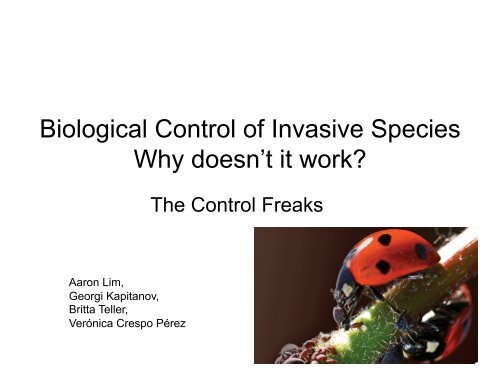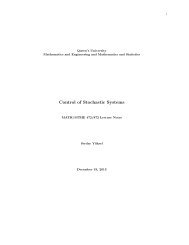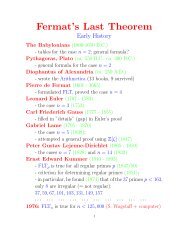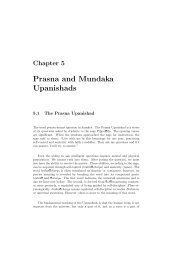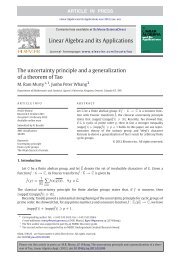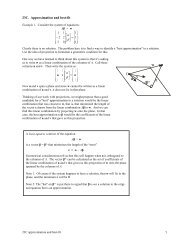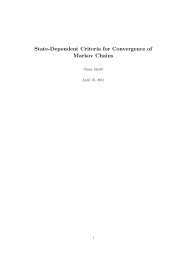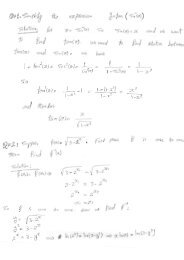Biological Control of Invasive Species Why doesn't it work?
Biological Control of Invasive Species Why doesn't it work?
Biological Control of Invasive Species Why doesn't it work?
Create successful ePaper yourself
Turn your PDF publications into a flip-book with our unique Google optimized e-Paper software.
<strong>Biological</strong> <strong>Control</strong> <strong>of</strong> <strong>Invasive</strong> <strong>Species</strong><br />
Aaron Lim,<br />
Georgi Kap<strong>it</strong>anov,<br />
Br<strong>it</strong>ta Teller,<br />
Verónica Crespo Pérez<br />
<strong>Why</strong> doesn’t <strong>it</strong> <strong>work</strong>?<br />
The <strong>Control</strong> Freaks
<strong>Biological</strong> invasions<br />
• Introduction and spread <strong>of</strong> exotic<br />
organisms in regions outside <strong>of</strong> their<br />
native range<br />
– advances in technology → increase in<br />
worldwide movement <strong>of</strong> humans and their<br />
goods<br />
Second largest cause <strong>of</strong> current biodivers<strong>it</strong>y<br />
loss after hab<strong>it</strong>at destruction<br />
(Keane & Crawley 2002)
Stages <strong>of</strong> invasions<br />
Liebhold & Tobin 2008<br />
1) Arrival<br />
2) Establishment<br />
3) Spread<br />
1. 2. 3.
Enemy Release<br />
Hypothesis<br />
“Introduced species should experience a<br />
decrease in regulation by natural enemies,<br />
resulting in an increase in distribution and<br />
abundance”<br />
(Keane & Crawley 2002)
Chemical<br />
<strong>Control</strong>ling invasive<br />
species<br />
Physical<br />
<strong>Biological</strong><br />
control
Natural<br />
enemies<br />
Native range<br />
<strong>Biological</strong> control<br />
Invaded range<br />
The abundance <strong>of</strong> an invasive species may be<br />
rapidly reduced by introducing specialist enemies<br />
from the native range<br />
time
<strong>Biological</strong> <strong>Control</strong> in Practice<br />
Purple loosestrife<br />
(Lythrum salicaria)
Problems w<strong>it</strong>h biological control:<br />
Nontarget effects<br />
Galerucella pusilla<br />
Rhinocilus conicus
<strong>Biological</strong> <strong>Control</strong> in Practice<br />
Spotted knapweed<br />
(Centaurea maculosa)
Problems w<strong>it</strong>h biological control:<br />
Urophora affenis<br />
Naturalization<br />
Peromyscus maniculatus
Our Objectives<br />
• Build a model to evaluate the potential <strong>of</strong> a<br />
“perfect biological control”<br />
– Assumes that the biological control is<br />
completely dependant on the invasive for<br />
reproduction.<br />
• Evaluate the parameter values over which<br />
equilibria exist and decide if they are<br />
biologically relevant
<strong>Control</strong><br />
<strong>Invasive</strong><br />
Native<br />
Our Model
Equilibrium Cond<strong>it</strong>ions
Assumed parameter estimates<br />
Parameter Value<br />
β N Birth rate <strong>of</strong> N 1<br />
µ N Death rate <strong>of</strong> N 0.1<br />
β I Birth Rate <strong>of</strong> I 50<br />
µ I Death Rate <strong>of</strong> I 0.1<br />
K Carrying capac<strong>it</strong>y 5000<br />
κ 1<br />
Number <strong>of</strong> births <strong>of</strong> C<br />
per (attack related) death<br />
<strong>of</strong> I<br />
0.5<br />
α N Attack rate <strong>of</strong> N on I .0001<br />
α I Attack rate <strong>of</strong> I on N 0< α I
Graphical Representations<br />
Equilibrium Dens<strong>it</strong>y
Parameter Constraints<br />
µc=0.2<br />
µc=0.5<br />
µc=0.8
What happens if the biological<br />
control is “leaky”?
<strong>Control</strong><br />
<strong>Invasive</strong><br />
Native<br />
Our Model
Equilibrium Cond<strong>it</strong>ions
Assumed parameter estimates<br />
Parameter Value<br />
β N Birth rate <strong>of</strong> N 1<br />
µ N Death rate <strong>of</strong> N 0.1<br />
β I Birth Rate <strong>of</strong> I 50<br />
µ I Death Rate <strong>of</strong> I 0.1<br />
K Carrying capac<strong>it</strong>y 5000<br />
κ 1<br />
Number <strong>of</strong> births <strong>of</strong> C per<br />
(attack related) death <strong>of</strong> I<br />
0.5<br />
α N Attack rate <strong>of</strong> N on I .0001<br />
α I Attack rate <strong>of</strong> I on N 0< α I
Graphical Representations<br />
Equilibrium Dens<strong>it</strong>y
Parameter Constraints
Conclusions<br />
• In a “perfect” biological control scenario, the<br />
control is effective at achieving a 3 species<br />
equilibrium when the biological control is<br />
aggressive and has a low death rate.<br />
• In the “leaky” biological control scenario the<br />
biological control is effective at achieving a 3<br />
species equilibrium however, there is overlap in<br />
the equilibrium parameter space and <strong>it</strong> is<br />
sens<strong>it</strong>ive to in<strong>it</strong>ial values.
Future Directions<br />
• Compensatory growth<br />
• Evolution<br />
• Poor estimates <strong>of</strong> parameters<br />
(all <strong>of</strong> which lead to the persistence <strong>of</strong> the<br />
invasive, control or both)
References<br />
RM. Callaway, TH. DeLuca, WM. Belliveau (1999) BIOLOGICAL-CONTROL<br />
HERBIVORES MAY INCREASE COMPETITIVE ABILITY OF THE<br />
NOXIOUS WEED CENTAUREA MACULOSA. Ecology: Vol. 80, No. 4, pp.<br />
1196–1201.<br />
R.M. Keane, M.J. Crawley (2002) EXOTIC PLANT INVASIONS AND THE<br />
ENEMY RELEASE HYPOTHESIS. TRENDS in Ecology & Evolution: Vol.<br />
17, No.4, pp. 164–170.<br />
A.M. Liebhold, P.C. Tobin (2008) POPULATION ECOLOGY OF INSECT<br />
INVASIONS AND THEIR MANAGEMENT. Annual Reviews <strong>of</strong> Entomology:<br />
Vol. 53, pp. 387–408.<br />
S. Louda, Kendall D, Connor J, Simberl<strong>of</strong>f D (1997) ECOLOGICAL EFFECTS<br />
OF AN INSECT INTRODUCED FOR THE BIOLOGICAL CONTROL OF<br />
WEEDS. Science: Vol. 277, No. , pp. 1087–90.<br />
H Müller-Schärer, U Schaffner, and T Steinger (2004) EVOLUTION IN<br />
INVASIVE PLANTS: IMPLICATIONS FOR BIOLOGICAL CONTROL.<br />
Trends in Ecology & Evolution: Vol. 19, No. 8, pp. 417–422.<br />
D. E. Pearson, K. S. McKelvey and L. F. Ruggiero (2000) NON-TARGET<br />
EFFECTS OF AN INTRODUCED BIOLOGICAL CONTROL AGENT ON<br />
DEER MOUSE ECOLOGY . Oecologia: Vol. 122, No. 1, pp. 121–8.
Images<br />
• http://plants.usda.gov/maps/large/LY/LYSA2.png<br />
• http://plants.usda.gov/maps/large/CE/CESTM.png<br />
• http://www.missouriplants.com/Pinkalt/Centaurea_maculosa_involucre.jpg<br />
• http://www.missouriplants.com/Pinkalt/Centaurea_maculosa_plant.jpg<br />
• http://www.fs.fed.us/r9/forests/wh<strong>it</strong>e_mountain/ecosystems/WMEDN/<br />
nnis_plants/images/purple_loostrife_flower_les.jpg<br />
• http://www.invasive.org/weedcd/images/1536x1024/5358645.jpg<br />
• http://freshcutspro.com/yahoo_s<strong>it</strong>e_admin/assets/images/CrepeMyrtle.<br />
96124546_large.jpg<br />
• http://www.zin.ru/Animalia/Coleoptera/images/kv_mak/<br />
galerucella_pusilla.jpg<br />
• http://www.fsoe.se/bilder/rhinocyllus_conicus.jpg<br />
• http://www.cedarcreek.umn.edu/mammals/midsize/peromyscusmaniculatus.jpg<br />
• http://upload.wikimedia.org/wikipedia/commons/thumb/6/63/Green_bug.svg/<br />
548px-Green_bug.svg.png<br />
• http://www.landcareresearch.co.nz/education/weeds/images/pullweed1.gif<br />
• http://www.extertronic.com/image/insect-protection/fly-natural-control.jpg<br />
• http://img0.gmodules.com/ig/cache/ca/a1/<br />
caa179188c1529420e032145a86af7cc.png<br />
• http://cipm.ncsu.edu/ent/biocontrol/images/banner_main.gif
Greetings from Banff!<br />
Look how much fun we<br />
had outside!


